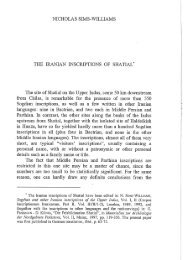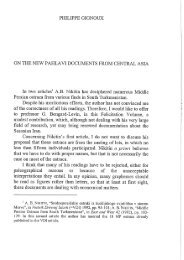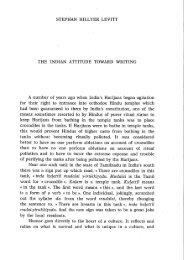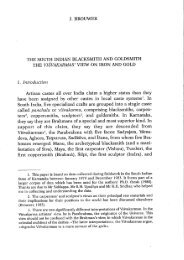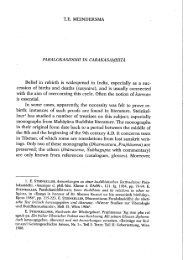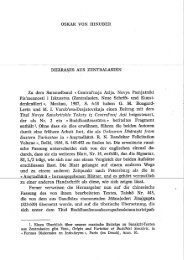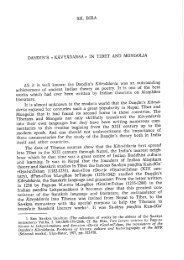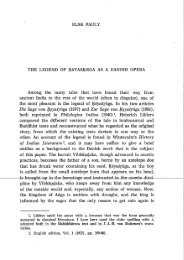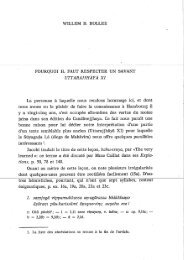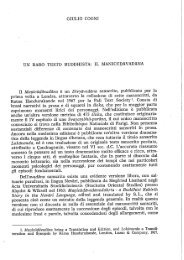T.Y. ELIZARENKOVA
T.Y. ELIZARENKOVA
T.Y. ELIZARENKOVA
You also want an ePaper? Increase the reach of your titles
YUMPU automatically turns print PDFs into web optimized ePapers that Google loves.
T.Y. <strong>ELIZARENKOVA</strong><br />
THE WORD ÅTMÁN IN THE ÀGVEDA<br />
Åtmán-, the supreme principle of individual existence (“soul”),<br />
opposed to bráhman, the supreme objective reality, is one of the capital<br />
notions in the religious system of Hinduism. Before this opposition<br />
was established in the Upanißads, both the words had a long history of<br />
semantic and formal development the beginning of which (like all the<br />
other beginnings) is found in the Àgveda (RV).<br />
This paper deals with the analysis of functions of the word åtmánin<br />
the Àgveda. It is based on the general ideas expressed by L. Renou<br />
in his article “On the word åtmán-” (Renou 1952 – where the history<br />
of this word in the Vedic period is traced) and presents an effort to<br />
give a synchronic description of the usage of åtmán- in the most<br />
archaic linguistic system of the Old Indian language.<br />
Åtmán- in the RV is a substantive of masculine gender used only in<br />
the singular. The word is of Indo-European origin, connected with the Old<br />
Saxon âthum, German Atem “breath” (Mayrhofer EWA I, 164). It is a<br />
polysemantic word peculiar in many respects. Its form is unusual, because<br />
practically it is represented by two variants, regarded by the dictionaries<br />
as two separate words: åtmán- and tmán- (e.g., Böhtlingk. I, 167 and III,<br />
45). Historically the type of vowel alternation: å/Ø which is not very frequent<br />
in Vedic takes place here (Kuiper 1942, 19 f.) and the paradigm of<br />
åtmán- is a reflection of an Indo-European accentually mobile paradigm:<br />
*éh 1 t-mø(n) – D.sg. *h 1 t-mén-ei (Mayrhofer ib.). As to its meanings, they<br />
are to a considerable degree distributed between the two stems, and within<br />
the limits of this distribution among separate cases.
122 T.Y. Elizarenkova<br />
There is a strong tendency to complementary distribution between<br />
the paradigms of åtmán- and tmán-: the former one is represented<br />
mainly by direct cases: N. and Acc., while the latter one consists<br />
almost exclusively of the indirect ones (first of all of the I. sg.).<br />
Besides, the forms of tmán- are inclined to be used adverbially, without<br />
any differences of nominal grammatical categories.<br />
Åtmán- is used 22 times in the hyms of the RV as an independent<br />
word, 4 times as a member of compound words (Lubotsky I, 247-<br />
248). There exists also an adjective derived from åtmán- – åtmanvánt-<br />
“possessing åtmán-” which is used 3 times. Åtmán- is a word that<br />
belongs mostly to the recent part of the RV: out of the 22 occurrences<br />
13 are found in ma∫∂alas I and X, only twice it is used in a “family”<br />
ma∫∂ala (VII, 87, 2 and VII, 101, 6), the rest belonging to ma∫∂ala IX<br />
– 4 times and VIII – 1 time. The variant tmán- is much more frequent,<br />
it is found 77 times in various parts of the text (Lubotsky I, 607-608).<br />
There exists also a feminine stem tmánœ- found twice in the later part<br />
of the text in the I. case tmányå (I, 188, 10 and X, 110, 10).<br />
According to Renou (ib. 151), “the word åtmán- denotes something<br />
which is at the base of the “animated” character of living beings<br />
(or, what comes to the same thing from the Vedic point of view, of<br />
beings which are for us inert, but are conceived of as living)”. A<br />
detailed description of its meanings in the RV is given by Grassmann<br />
in his dictionary of this samhitå: 1) Hauch; 2) Athem, Odem,<br />
Lebenshauch; 3) Lebensgeist, Lebensprincip; 4) vom Geiste der<br />
Krankheit (yákßmasya) wird es einmal gebraucht; 5) der lebendige<br />
Leib, als Einheit aufgefasst (Grassmann 175). Only the meanings “person”<br />
and “self”, which are very close to that of a reflexive pronoun are<br />
missing here, whereas they are mentioned in other Sanskrit dictionaries<br />
(Böhtlingk I, 167; Monier-Williams 135). It should be said that the<br />
reflexive meaning occupies a peripheral place in the semantic volume<br />
of åtmán-, while it is the first meaning of the variant tmán-.<br />
The paradigm of åtmán- consists of the following cases in the singular:<br />
N. – 15 times, Acc. – 4, Abl. – 2, L. – 1, thus the N. being the most<br />
frequent of cases. The usual function of the N., as it is well known, is that<br />
of the subject of a sentence coordinated with the verbal predicate. But the<br />
situation with åtmán- is different. Only 3 times out of 15 it is connected<br />
with a finite form of the verb. These are the following passages.
The word åtmán in the Àgveda<br />
123<br />
I, 162, 20: må´ två tapat priyá åtmå´piyántam | må´ svádhitis tanvà<br />
å´ tißhipat te “Let not your dear soul burn you as you go away. Let not<br />
the axe do lasting harm to your body” (O’Flaherty 91). This is<br />
addressed to the sacrificial horse, who should not be sad parting with<br />
his life. Renou in his comments notices: "Noter åtmán- en regard de<br />
tanǽ , le premier étant attaint moralement, le second attaint physiquement"<br />
(Renou EVP XVI, 87).<br />
X, 16, 3: sǽryaμ cákßur gachatu vå´tam åtmå´ “May your eye go to<br />
the sun, your life’s breath to the wind” (O’Flaherty 49). These words<br />
are said in a funeral hymn to a dead man whose body is cremated by<br />
Agni, and who is said to go into the three worlds. O’Flaherty is of the<br />
opinion: “Indeed, it seems to be the body, not the soul of the dead man<br />
that Agni is asked to lead to heaven, to Yama, to the fathers, and to the<br />
gods, the body that is the focus of the entire hymn” (ib. 48). And<br />
Geldner comments on it that åtmå´ is used here in the meaning of a<br />
more recent prå∫á (the latter denoting physical breathing, respiration)<br />
(Geldner 3, 147). Important is also the connection of åtmán- with<br />
vå´ta- which testifies to the meaning of physical breathing.<br />
X, 97, 11: yád imå´ våjáyann ahám<br />
óßadhœr hásta ådadhé |<br />
åtmå´ yákßmasya naƒyati<br />
purå´ jœvagΏbho yathå ||<br />
“When I take these plants in my hand, yearning for the victory<br />
prize, the life of the disease vanishes, as if before a hunter grasping at<br />
his life” (O’Flaherty 285-286).<br />
This is a verse from a laudation of the healing plants, and the<br />
word åtmán- is used here as a synonym of jœvá- – Geldner translates<br />
åtmán- as “Lebensgeist” (Geldner 3, 307).<br />
All the three passages speak for the fact that åtmán- is something<br />
that is situated inside of his subject, be it a horse, a man or a disease. It<br />
can burn or torment his subject from inside, can go outside by itself or<br />
be forced to do it.<br />
The rest of the occurrences of åtmán- in the N. are found only in<br />
sentences without predicates, expressed by a finite form of a verb. It<br />
may be a sentence with an elided link-verb. E.g., I, 115, 1: sǽrya åtmå´<br />
jágatas tasthúßaƒ ca “The Sun (is) the vital breath of what moves and<br />
what is still” (the same formula is in VII, 101, 6); VIII, 3, 24: åtmå´
124 T.Y. Elizarenkova<br />
pitús tanǽr vå´sa | ojodå´ abhyáñjanam “Food (is) the soul, clothes the<br />
body, unguent is granting power”, where the opposition of soul and<br />
body takes place; X, 107, 7: dakßi∫å´nnaμ vanute yó na åtmå´ “Dakßi∫å<br />
obtains food which (is) our soul” (or “vital breath”); I, 164, 4: bhǽmyå<br />
ásur ásΩg åtmå´ kvà svit “Where (was) the vital strength of the earth,<br />
blood and soul?”.<br />
The N. case of åtmán- is used in the predicative function. E.g.,<br />
IX, 2, 10:<br />
goßå´ indo nΩßå´ asy<br />
aƒvaßå´ våjaså´ utá |<br />
åtmå´ yajñásya pærvyáΔ ||<br />
“You are gaining cows, O drop (of Soma), gaining men, gaining<br />
horses and gaining prizes. You are the ancient essence of the sacrifice”;<br />
IX, 85, 3: åtméndrasya bhavasi dhåsír uttamáΔ “You are the<br />
vital principle of Indra, the supreme nourishment”.<br />
It should not escape one’s attention that åtmán- is three times<br />
identified with nourishment: pitú- (VII, 101, 6), ánna- (X, 107, 7) and<br />
dhåsí- (IX, 85, 8), which gives grounds to suppose that the “soul”,<br />
“living principle” was regarded as something physical, material,<br />
closely connected with the body.<br />
The N. case of åtmán- is used as an apposition to the subject,<br />
which is characteristic of the style of the hymns (Elizarenkova 1995,<br />
203 f.). E.g., VII, 87, 2: åtmå´ te vå´to rája å´ navœnot “The wind, your<br />
breath howled mightily through the space” (about Varu∫a); IX, 6, 8:<br />
åtmå´ yajñásya ráμhyå | sußvånáΔ pavate sutáΔ “Essence of the sacrifice,<br />
well pressed with rapidity, Soma is clarifying”; X, 168, 4: åtmå´<br />
devå´nåm bhúvanasya gárbho | yathåvaƒáμ carati devá eßáΔ “Breath<br />
of the gods, embryo of the universe, this god wanders wherever he<br />
pleases” (O’Flaherty 176) (about Våta).<br />
This case is also found in comparisons which are usually elliptical.<br />
E.g., I, 34, 7: tisró nåsatyå rathyå paråváta | åtméva vå´taΔ<br />
svásarå∫i gachatam “O Nåsatyas-charioteers, come through three distances<br />
to the pastures like the wind!”; I, 73, 2: purupraƒastó amátir ná<br />
satyá | åtméva ƒévo didhißå´yyo bhæt “The one who is much extolled,<br />
who is real like the image (of the sun), precious like his own self (for a<br />
person), he should be gained!” (about Agni).<br />
The analysis of the functioning of åtmán- in the N. case in the RV
The word åtmán in the Àgveda<br />
125<br />
shows that one cannot be certain in answering the question: what is<br />
åtmán- doing in the RV. It simply exists inside of his subject. It seems<br />
to be connected with the body, being sometimes identified with food,<br />
and at the same time it has the nature of the wind (I, 34, 7; VII, 87, 2;<br />
X, 16, 3; X, 168, 4).<br />
The Acc. case of åtmán – is found 4 times. It is governed by the<br />
verbs jñå – “to know”, “to comprehend”; arc – “to praise, sing, honour”;<br />
san – “to gain, acquire”. E.g., I, 163, 6: åtmå´- naμ te mánasårå´d<br />
ajånåm “I have comprehended your essence from afar by my thought”<br />
(about a deified horse) – Geldner translates it: “dein eigenes Selbst”<br />
(Geldner 1, 226); X, 92, 13: åtmå´naμ vásyo abhi vå´tam arcata “Praise<br />
the wind, breath (of the gods), so that (things may became) better (for<br />
us)! 1 ” – again with the identification of åtmán- with the wind; X, 97,<br />
4: sanéyam áƒvaμ gå´μ vå´sa | åtmå´naμ táva pærußa “Let me win a<br />
horse, a cow, a robe – and your very life, O man” (O’Flaherty 285)<br />
(the words of the curer in the hymn to the healing plants); X, 97, 8: ...<br />
[ƒ]úßmå óßadhœnåμ | ... dhánaμ sanißyántœnåm | åtmå´naμ tava<br />
pærußa “... the powers of the plants that will win wealth – and your<br />
life, O man” (ib.) (the last two examples containing the same formula).<br />
In all these examples åtmán- is an abstract notion that can be<br />
understood, gained, and that should be praised.<br />
The Abl. case of åtmán- is testified twice in the two last verses of<br />
a hymn the aim of which is to remove the illness called yákßmå 2 from<br />
a sick man – X, 163, 5 and 6. Verse 6, for instance, reads as following:<br />
án - gåd-an - gåd lómno-lomno<br />
jåtám párva∫i-parva∫i |<br />
yákßmaμ sárvasmåd åtmánas<br />
tám idáμ ví vΩhåmi te ||<br />
“From every limb, from every hair, from the entire body, I tear<br />
away for you this yákßma born in every joint” (Zysk 108). A similar<br />
enumeration of various parts of the body as opposed to the whole<br />
body, åtmán-, takes place in verse 5.<br />
1. Commenting on this passage Renou says: L’un des exemples les plus nets<br />
pour confirmer le sens premier d’åtmán (Renou EVP IV, 126).<br />
2. According to Zysk, it is tuberculosis or consumption (Zysk, 12 f.).
126 T.Y. Elizarenkova<br />
Once åtmán- is found in the L. case – IX, 113, 1: ƒarya∫å´vati<br />
sómam | índraΔ pibatu vΩtrahå´ | bálaμ dádhåna åtmáni “Let Indra,<br />
the killer of VΩtra, drink Soma in ˙arya∫åvat gathering his strength<br />
within himself ...”. The meaning of åtmán- in this context is that of a<br />
reflexive pronoun.<br />
The analysis of the lexical meanings of åtmán- represented by<br />
various cases gives a scale of meanings, beginning with “breath”,<br />
“soul” and ending with “body”. Thus, the concept of soul was not<br />
strictly separated from the physical substance – they were linked<br />
together by a continuous chain of lexical shades.<br />
It should not escape one’s attention that the G. case (which in<br />
general, is a frequent one) is missing in the paradigm of åtmán-. As<br />
the concept “which is at the base of the “animated” character of living<br />
beings” (Renou), åtmán- stands by itself, and is not characterized by<br />
any other notions. At the same time it takes part in G. constructions as<br />
its governing member: åtmå´ jágatas tasthúßaƒ ca (I, 115, 1; VII, 101,<br />
6) “the vital breath of what moves and what is still”; åtmå´ yajñásya<br />
(IX, 2, 10; IX, 6, 8) “the essence of the sacrifice”; åtméndrasya (IX,<br />
85, 3) “the vital principle of Indra”; åtmå´ yákßmasya (X, 97, 11) “the<br />
life of the disease”; åtmå´ devå´nåm (X, 168, 4) “breath of the gods”;<br />
åtmå´naμ táva pærußa (X, 97, 4 and 8) “your life, O man”.<br />
The list of adjectival attributes to åtmán- is rather short: ƒéva –<br />
“precious”; priyá – “dear” (and “one’s own”); pærvyá – “ancient”;<br />
sárva – “whole”.<br />
Åtmán- is also used as a member of two compound words, both<br />
being adjectives: åtmadå´ – “giving life” and ƒatå´tman – “having hundred<br />
lives”. The first one is found only once in a cosmogonic hymn<br />
addressed to an unknown god (ká – “who?”). X, 121, 2: yá åtmadå´<br />
baladå´ yásya víƒva | upå´sate praƒíßaμ yásya devå´Δ “He who gives<br />
life, who gives strength, whose command all the gods, his own, obey<br />
...” (O’Flaherty 27). The second one is testified three times. IX, 98, 4:<br />
índo sahasrí∫aμ rayíμ | ƒatå´tmånaμ vivåsasi “O drop (of Soma), you<br />
want to gain a treasure, consisting of thousand (different objects), possessing<br />
hundred lives”. This is the interpretation of Geldner: “der hundert<br />
Leben hat” (Geldner 3, 102). But Renou understands it in a somewhat<br />
different way: “consistant en cent êtres-animés” (Renou EVP IX,<br />
52), and explains it in his comment: “Ici, il s’agit de la richesse con-
The word åtmán in the Àgveda<br />
127<br />
sistant en vœrá's, le vœrávantaμ rayím, passim”.<br />
The two other examples are found in the most recent parts of the<br />
text. I, 149, 3: sǽro ná rurukvå´ñ chatå´tmå “... shining like the sun,<br />
possessing hundred lives”. It is said about Agni. Geldner’s translation<br />
is “mit hundertfachem Leben” (Geldner 1, 207), that of Renou: “doué<br />
de cent principes-animés” (Renou EVP XII, 39). X, 33, 9: ná devå´nåm<br />
áti vratám | ƒatå´tmå caná jœvati “No one lives beyond the decree of<br />
the gods, not even if he has a hundred souls” (O’Flaherty, 65).<br />
Geldner’s translation seems to suit more to this context: “auch wenn<br />
er hundert Leben hätte” (Geldner 3, 183). Renou’s comment is in<br />
accordance with his general views: “(un mortel) qui disposerait<br />
(même) de cents principes – vitaux” (Renou EVP IX, 111).<br />
No matter how to understand the meaning of åtmán- as a member<br />
of a compound: as life, animated being or vital principle, it is clear that<br />
in this function it is neither reflexive, nore connected with the body.<br />
There exists also an adjective derived from åtmán- – åtmanvánt-<br />
“animated” which is found three times in the hymns. Once it is an<br />
attribute to the cloud – IX, 74, 4: åtmánván nábho duhyate ghΩtám<br />
páya[Δ] “The animated cloud is yielding clarified butter (and) milk”<br />
(about Soma). The two other occurrences belong to the Aƒvin-myth<br />
and their animated ships. I, 182, 5: yuvám etáμ cakrathuΔ síndhußu<br />
plavám | åtmanvántam pakßí∫aμ taugryå´ya kám “You made this animated<br />
winged ship amid the streams for the son of Tugra”; I, 116, 3:<br />
tám æhathur naubhír åtmanvátœbhir ... “You brought him back ... in<br />
ships that were alive ...” (O’Flaherty, 182). These contexts show that<br />
åtmán- functioning as an underlying word means “life”.<br />
If one wants to establish the meaning of a word in a certain text,<br />
the investigation of its paradigm, of characteristic syntactic structures<br />
and derivational models is, so to say, an inner analysis which is necessary,<br />
but not enough. It should be supplemented by an “outer” analysis<br />
– the investigation of the semantic field to which this word belongs so<br />
as to draw the lines of demarcation between the synonyms. Renou<br />
begins his description with this procedure, saying that åtmán- in the<br />
RV is akin to two terms: ásu- and prå∫á-. Both are “the vital breath”,<br />
prå∫á in the proper and so to say physiological sense; ásu in clear<br />
connection with death and the beyond, and at times approaching the<br />
notion of “psychè” (Renou 1952, 151).
128 T.Y. Elizarenkova<br />
The comparison with prå∫á- is the most obvious one. Prå∫áwhich<br />
is found in the hymns 5 times (4 times in the recent part of the<br />
text) (Lubotsky II, 947-948) is explained by its etymology, being<br />
derived from the verbal root an- “to breathe” with the prefix prá. The<br />
meaning is “breath” in general and “expiration”. Once this etymology<br />
is played upon by the Àßi – X, 189, 2: antრcarati rocanå´- | asyá<br />
prå∫å´d apånatœ´ “She is moving between the two luminous spaces,<br />
inhaling (life) from his expiration”. Renou comments that Ußas (she)<br />
and Særya (he) are regarded here as the total respiration of the world<br />
(Renou EVP XV, 13). In the Purußa-sækta prå∫á- is mentioned in the<br />
same list with other parts of the body, like the eye (cákßu-) and the<br />
mouth (múkha-). It says in X, 90, 13: prå∫å´d våyúr ajåyata “The wind<br />
was born from his breath”. Thus, similar to åtmán- prå∫á- is correlated<br />
with the wind.<br />
As to ásu-, the situation here is much more complicated. It is a<br />
word which is not frequent in the hymns, found only 10 times used<br />
independanly (only once in a family ma∫∂ala, and the rest in the<br />
recent ma∫∂alas I and X). Besides it is found as a member of compounds<br />
ásunœti- f. “sending off of the existence (to the other world)”,<br />
also personified, and asutΏp- adj. “taking away the existence”<br />
(Lubotsky I, 181). Renou takes ásu- for one of the denominations of<br />
“the vital breath” (Renou 1952, 151). This is the meaning given in the<br />
St. Petersburg dictionary: “Lebenshauch, Leben” (Böhtlingk 1, 150),<br />
as well as by Monier-Williams: “breath, life” (Monier-Williams 121).<br />
And only in Grassmann’s dictionary the meaning “breath” is missing,<br />
and the main meaning of ásu- is “Leben” (the word ásu- being derived<br />
from the root as- “to be”, “to exist”) (Grassmann 155).<br />
Much later Schlerath argued in an article in favour of this latter<br />
viewpoint, basing on the material of ásu in the RV and ahu- in the<br />
Avesta. He comes to the conclusion, “dass ásu- im RV/AV nicht<br />
“Lebensodem, Orenda” bedeutet, sonder “Leben, Existenz, individuelle<br />
Existenz (auch nach dem Tode)”. Alles spricht für Ableitung aus<br />
as-, nichts für Ableitung aus an-” (Schlerath 1968, 150). Mayrhofer in<br />
his etymological dictionary accepts Schlerath’s interpretation<br />
(Mayrhofer EWA I, 147).<br />
As åtmán- is treated in the RV as the vital breath, vital principle,<br />
it is semantically very close to ásu-, denoting life and individual exis-
The word åtmán in the Àgveda<br />
129<br />
tence. The two words are synonymous in this meaning, but some differences<br />
between the synonyms can also be traced in the hymns. It<br />
was noticed both by Renou and by Schlerath that ásu- is correlated to<br />
death. Existence denoted by ásu- can also last after death. Cp. X, 12,<br />
4: áhå yád dyå´vó ’sunœtim áyan | mádhvå no átra pitárå ƒiƒœtåm<br />
“When (our) days, days and nights go to the other world, let our two<br />
parents charpen then our (poetical vision) with the help of the sweet<br />
(Soma) 3 ”. Commenting on these lines, Renou says: “ásunœti – expression<br />
typique du Livre X, notamment dans la brève saμhitå mortuaire –<br />
équivaut à “mort” (avec idée latente d’un autre monde” (Renou EVP<br />
XIV, 72). Åtmán- in contradistinction to ásu- is not connected with<br />
death in any way.<br />
Åtmán- is situated inside its subject, while ásu- is a state which<br />
can be entered by the subject. Cp. X, 12, 1: ... devó yán mártån<br />
yajáthåya kΩ∫ván | sœ´dad dhótå pratyán - svám ásuμ yán “...when the<br />
god making the mortals sacrifice, takes his place as hotar, coming into<br />
the state of existence which is proper to him”. The god Agni is meant<br />
here, who becomes a hotar again after a period, when he was smoldering<br />
under the ashes. Renou translates it: “retournant (ainsi) vers son<br />
proper être-vital” (Renou EVP XIV, 9).<br />
Though åtmán- in some contexts is opposed to tanǽ- “body”<br />
(VIII, 3, 24; I, 162, 20), there are cases, when åtmán- is denoting the<br />
body and not the soul (X, 163, 5 and 6, where yákßμa- is expelled<br />
from åtmán- “the body” in the Abl. case). Besides, the meaning of a<br />
reflexive pronoun which is found in the L. case of åtmán- (IX, 113, 1:<br />
bálaμ dádhåna åtmáni) is rather close to that of the body: “gathering<br />
his strength within his body” 4 . The concept of ásu- is not correlated in<br />
a strict sense to the body.<br />
The variant of the stem tmán- is found in the text as an independent<br />
word 77 times in all the ma∫∂alas (Lubotsky I, 607-608). It is also<br />
used like åtmán- only in the singular. Its paradigm consists almost<br />
exclusively of indirect cases – the Acc. is found only once. The I. case<br />
3. The translation follows in general Renou’s interpretation of this passage<br />
(Renou EVP XIV, 9).<br />
4. Some considerations about the mutual relations of tanǽ- and åtmán- see (T.<br />
Elizarenkova, 2003).
130 T.Y. Elizarenkova<br />
is the most frequent one – it is used 63 times, the rest are the L. – 7<br />
times and the D. – 6 times. Besides, there exists a stem with a feminine<br />
ending tmánœ- which is used twice. Thus, there exists an evident complementary<br />
distribution between the two variants of the stem: åtmándirect<br />
cases, tmán- indirect ones. It is broken by a single occurrence of<br />
the Acc. case from the stem tmán- – I, 63, 8: tváμ ...| íßam ... pœpayaΔ<br />
...| yáyå ƒæra práty asmábhyaμ yaμsi | tmánam ǽrjaμ ná viƒvádha<br />
kßáradhyai “You made swell the refreshment, by means of which you,<br />
O hero, bestow on us vigour (which is your) apanage, so that it may<br />
stream in all directions” 5 . One can understand here tmánam- as the<br />
characteristic feature of Indra, the essence of his nature. This way,<br />
tmán- is used here in the meaning of åtmán-, from which it is formally<br />
differentiated only by the short a of the stem vowel.<br />
The lexical meaning of all the indirect cases of tmán- is largely<br />
that of a reflexive pronoun based on the notion of “person” (Renou,<br />
1952, 153). Renou notices that these are weak reflexives: “by itself”;<br />
“in one’s own”, and that they fall to the level of particles (ib.).<br />
Grassmann notes that the singular of tmán- can be correlated to<br />
all the grammatical numbers of the corresponding substantive. E.g. III,<br />
3, 10: ágne tå´ víƒvå paribhǽr asi tmánå “O Agni, you envelop by<br />
yourself all these (things)” (or “by your person”); IX, 102, 7: samœcœné<br />
abhí tmánå | yahvœ´ Ωtásya måtárå “Two young women, mothers of the<br />
Cosmic Law, (rush) to (him) in their own persons”; VII, 34, 6: tmánå<br />
samátsu hinóta yajñáμ “Hurry yourselves the sacrifice in the contests!”.<br />
That means that tmán- does not express the grammatical category<br />
of number.<br />
The same can be said about the grammatical category of gender.<br />
Forms of tmán- with the inflexion of the masculine-neutral type can<br />
be correlated to the substantives of the feminine gender. E.g., VII, 84,<br />
1: prá våμ ghΩtå´cœ båhvór dádhånå | pári tmánå víßuræpå jigåti “(The<br />
sacrificial spoon [f.]) full of ghee; which (we) are holding in our<br />
hands, is moving round you by itself, acquiring various forms” (to<br />
Indra and Varu∫a) – cp. with V, 15, 4, where the subject is Agni: pári<br />
tmánå víßuræpo jigåsi “You are moving around by yourself”.<br />
5. The translation follows Renou’s interpretation (Renou EVP XVII, 27).
The word åtmán in the Àgveda<br />
131<br />
The two occurrences of the I. sg. tmányå from the feminine stem<br />
tmánœ- are found in similar contexts in the 10 th verse of the åprœ hymns<br />
which is addressed to the sacrificial pole vánaspáti- (this substantive<br />
being of the masculine gender). I, 188, 10: úpa tmányå vanaspate |<br />
på´tho devébhyaΔ sΩja “O great tree, you should by yourself let (the<br />
sacrificial animal) go under the guard to the gods!” The other passage<br />
X, 110, 10 is very close to this one.<br />
The ability of the stem tmán- to express the grammatical category<br />
of case is rather limited. The single occurrence of the Acc. case of<br />
tmán- does express the usual meaning of this case grammeme – that of<br />
the direct object governed by a transitive verb (see p. 13).<br />
The most frequent I. case (63 times) has usually the meaning of a<br />
reflexive pronoun of various lexical shades, which are indistinct and<br />
bordering with the meaning “person”. Sometimes they lose their<br />
pronominal status, becoming adverbs (like svayám) or particles. Still<br />
there are some contexts which give grounds to trace the meanings of<br />
instrumentality, agency and the like of the form tmánå, but they are<br />
rather vague. E.g., IV, 53, 5: tribhír vratáir abhí no rakßati tmánå “He<br />
protects us by himself with his three decrees” (about Agni). Geldner<br />
translates it: “in eigner Person” (Geldner 1, 484), Renou: “de luimême”<br />
(Renou EVP, XV, 21). But more often the meaning of the I.<br />
case is not at all evident. E.g., I. 54, 4: -áva tmánå dhΩßatå´ ƒámbaram<br />
bhinat “You yourself have boldly split Shambara”. II, 25, 2: góbhœ<br />
rayím paprathad bódhati tmánå “He expanded his riches by means of<br />
cows: (thus) he attends to himself”; VIII, 84, 3: rákßå tokám utá<br />
tmánå “Protect (our) offspring and also ourselves!” etc.<br />
The L. case is represented by two forms: tmán at the end of a<br />
påda, and tmáni in other positions. Not a single one out of the 7 testified<br />
forms (tmán – 5 times and tmáni – 2) expresses the meaning of<br />
this case grammeme: sphere where the action takes place, or place of<br />
destination with the verbs of movement. Forms of the L. case of tmánhave<br />
practically the same meanings as those with the inflexion of the<br />
I. case. E.g., IV, 4, 9: ihá två bhǽry å´ cared úpa tmán “He should take<br />
much care of you here himself”; IV, 29, 4: úpa tmáni dádhåno dhury<br />
å`ƒæn | sahásrå∫i ƒatå´ni vájrabåhuΔ “(When) he who wields the thunderbolt<br />
in his hand himself (was) yoking swift horses to the pole –<br />
thousands, hundreds”.
132 T.Y. Elizarenkova<br />
Only forms with the inflexion of the D. case possess the meaning<br />
of this grammeme – they express the person for whose advantage the<br />
action takes place. All the 6 occurences of the D. sg. tmáne are used in<br />
opposition with tánayåya or tokå´ya – the poet asks the deity to do<br />
something “for our offspring and for ourselves”. E.g., I, 114, 6: tmáne<br />
tokå´ya tánayåya mΩ¬a “Have mercy on ourselves, on (our) children<br />
and grandchildren!” (to Rudra); VII, 62, 6 (= VII, 63, 6): nǽ mitró<br />
váru∫o aryamå´ nas | tmáne tokå´ya várivo dadhantu “So, let Mitra,<br />
Varu∫a, Aryaman grant wide space on ourselves and on (our) offspring!”.<br />
A similar situation is found in the rest of examples (I, 183, 3<br />
= VI, 49, 5; I, 184, 5).<br />
The loss of the reflexive meaning and transition to the meaning of<br />
adverbs, particles (or other emphatic devices) concerns indiscriminately<br />
forms with the inflexion of the I. and L. cases. Cp. iva tmánå in<br />
III, 9, 5: sasΩvå´μsam iva tmánå- | agním itthå´ tiróhitam | áinaμ nayan<br />
måtaríƒvå paråváto ... “Agni who had run away as if deliberately,<br />
(who) had been hidden that way – Måtariƒvan brought him from afar”<br />
(or “as if by himself”) and iva tmán in IX, 88, 3: viƒvávåro dravi∫odå´<br />
iva tmán- | pæßéva dhœjávano ’si soma “Having all the treasures like a<br />
real Dravi∫odas, you are like Pæßan, inciter of poetical thoughts, o<br />
Soma”. Renou translates it: “Dravi∫odas en personne” (Renou EVP<br />
IX, 38).<br />
One can say, drawing the conclusion, that the stem tmán- distinguishes<br />
practically two cases: the D. case and the non- D. case, represented<br />
by two variants with the inflexion either of the I. or of the L.<br />
case, both expressing the meaning of a reflexive pronoun. The single<br />
form of the Acc. case with the typical meaning of this grammeme<br />
makes an exception.<br />
There is one occurrence of a compound word with tmán- – purutmán-<br />
"having various existences", an epithet of Indra in VIII, 2, 38: ...<br />
ƒrávaskåmam purutmå´nam | ká∫våso gåtá våjínam "O Ka∫vas, sing<br />
the one who is fond of fame, who has various existences, the victorious<br />
one!". The stem tmán- as a member of this compound has the lexical<br />
meaning of åtmán-.<br />
This way the word åtmán- / tmán- distinguishes itself in the RV<br />
in many respects. It is by the existence of two variants of the stem,<br />
reflecting an ancient type of vowel alternation, and functioning as two
The word åtmán in the Àgveda<br />
133<br />
separate words; by the difference in their ability to express the grammatical<br />
categories; by the distribution of lexical meanings between<br />
them.<br />
Unusual is also the further history of this word in the development<br />
of the Indo-Aryan languages. The variant tmán- has almost disappeared<br />
after the RV, and, as Renou says, it is very probable that<br />
before disappearing, it has transferred its meanings “person” and that<br />
of a reflexive pronoun to åtmán- (Renou 1952, 153). As a result of<br />
this development, tadbhava words in the New Indo-Aryan languages<br />
that originate from åtmán- are pronouns like the Hindœ åp “you”<br />
(politely) (Turner 1966, 51). At the same time åtmán- opposed to<br />
bráhman 6 – as a tatsama word, that is a borrowing from Sanskrit,<br />
became a denomination of one of the central concepts of all the Indian<br />
schools of philosophy.<br />
LITERATURE<br />
Böhtlingk – Böhtlingk O., Sanskrit – Wörterbuch in kürzerer<br />
Fassung. 1.-7. Theil. St. Petersburg, 1879-1889.<br />
Elizarenkova 1995 – Elizarenkova T.J., Language and style of the<br />
Vedic Àßis. Albany, 1995.<br />
Elizarenkova 2003 – Elizarenkova T.Y., On the meaning of words<br />
signifying "body" in the Àgveda, in: 12 th World Sanskrit Conference.<br />
Helsinki, Finland, 13-18 July, 2003. Programme and Abstracts, 12-13.<br />
Geldner – Geldner K.F., Der Rig-Veda aus dem Sanskrit ins<br />
Deutsche übersetzt. 1.-3. Teil. Cambridge, Mass., 1951 (= Harvard<br />
Oriental Series, vol. 33-35).<br />
6. It should be said that the two words åtmán- and bráhman- are not correlated<br />
to each other in any way in the RV, and bráhman- in the hymns denotes sacred<br />
speech, spell etc.
134 T.Y. Elizarenkova<br />
Grassmann – Grassmann H., Wörterbuch zum Rig-Veda.<br />
Wiesbaden, 1955 (3. Aufl.).<br />
Kuiper 1942 – Kuiper F.B.J., Notes on Vedic noun-inflexion.<br />
Amsterdam, 1942.<br />
Lubotsky – Lubotsky A., A Àgvedic Word-Concordance. Part I-<br />
II. New Haven, 1997.<br />
Mayrhofer EWA – Mayrhofer M., Etymologisches Wörterbuch<br />
des Altindoarischen. I.-III. Bd. Heidelberg, 1986-2001.<br />
Monier-Williams – Monier-Williams M., A Sanskrit – English<br />
Dictionary. Oxford, 1970 (1 st ed. 1899).<br />
O’Flaherty – The Rig-Veda. An Anthology. One hundred and<br />
eight hymns, selected, translated and annotated by Wendy Doniger<br />
O’Flaherty. Penguin Books, 1981.<br />
Renou 1952 – Renou L., On the word åtmán. Våk 2, 1952, pp.<br />
151-157 (in: Louis Renou. Choix d’études indiennes. Réunies par N.<br />
Balbir et G.-J. Pinault. Paris, 1997, pp. 877-883).<br />
Renou EVP – Renou L., Études védiques et på∫inéennes. T. I-XVII.<br />
Paris, 1955-1969.<br />
Schlerath 1968 – Schlerath B., Altindisch asu-, Awestisch ahuund<br />
ähnlich klingende Wörter, in: Pratidånam. Indian, Iranian and<br />
Indo-European studies. Presented to F.B.J. Kuiper on his 60 th birthday.<br />
The Hague. Paris, 1968, pp. 142-153.<br />
Turner – Turner R.L., A comparative dictionary of the Indo-<br />
Aryan languages. London, 1966.<br />
Zysk – Zysk K.G., Religious healing in the Veda. Philadelphia,<br />
1985.



